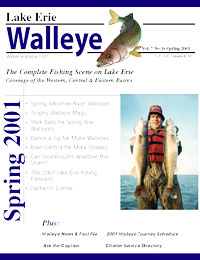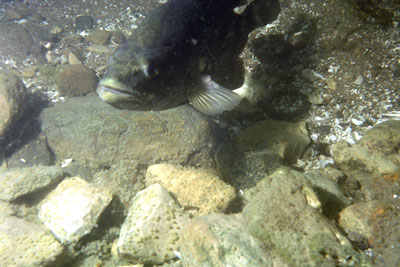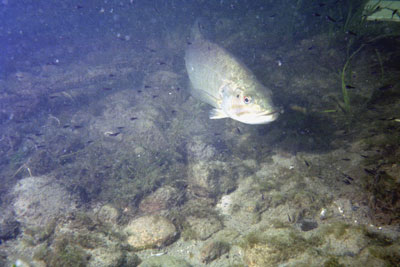Can Smallmouths Weather
the Storm?
by Lisa Denlinger
Ohio Sea Grant

Order Lake
Erie Walleye Magazine
Three Information-Packed Issues for only $10.00
Delivered to your doorstep every March, June and September
|
Can Smallmouths Weather
the Storm?
|
|
A
s the smallmouth bass continues its prominence as a key sport fish in Lake Erie waters, fishery managers have recognized that in order to ensure future populations, they must identify
factors that influence the speciesí spawning season. Ohio Sea Grant recently
had the opportunity to assist a team of researchers funded by the Ohio
Division of Wildlife at Stone Laboratory on Lake Erie. Led by Dr. Roy Stein,
Dr. Elizabeth Marschall, and Geoffrey Steinhart of The Ohio State University,
the team explored the most common dangers faced by young smallmouth bass.
recognized that in order to ensure future populations, they must identify
factors that influence the speciesí spawning season. Ohio Sea Grant recently
had the opportunity to assist a team of researchers funded by the Ohio
Division of Wildlife at Stone Laboratory on Lake Erie. Led by Dr. Roy Stein,
Dr. Elizabeth Marschall, and Geoffrey Steinhart of The Ohio State University,
the team explored the most common dangers faced by young smallmouth bass.
"Several factors threaten the survival of young smallmouth bass," states Geoff Steinhart, the projectís research associate. "Adequate parental care is crucial for the young along with a parentís ability to ward off the round goby. However, our research has found that the biggest dangers to the young fish are storms," continues Steinhart.
Adult male smallmouth bass guard their nests for approximately four to six weeks. During this time, each adult male fans its nest to protect the young from nest predators, such as the round goby. The fanning action oxygenates the surrounding water and prevents silt from suffocating the offspring.
Using video observations of smallmouth bass nest care along with
bioenergetic modeling, the researchers will determine the average amount of
energy smallmouth bass expend during nesting. Previous research has shown that
when the energy levels of male smallmouth bass are depleted, the male will
abandon its nest. With this abandonment, the fish forfeits its current
offspring to survive long enough to successfully reproduce in t he
future. Predators that venture near the nest risk being eaten by the male
smallmouth bass. The parents who gain nourishment in this way are able to
guard their nests for longer time periods. Although attacking the nest
predators is energetically costly, this behavior may help to reduce the rate
at which male smallmouths abandon their nests.
he
future. Predators that venture near the nest risk being eaten by the male
smallmouth bass. The parents who gain nourishment in this way are able to
guard their nests for longer time periods. Although attacking the nest
predators is energetically costly, this behavior may help to reduce the rate
at which male smallmouths abandon their nests.
Round gobies may provide a quick meal to the busy male smallmouth bass, but this benefit probably does not balance the threat these invaders pose to smallmouth young. Male smallmouth bass must stay on their nests constantly to ensure that round gobies do not eat any of their offspring. To determine how much damage round gobies can cause to smallmouth bass nests during a catch and release scenario, the team developed an inventive approach to angling. While wearing scuba gear, team members were able to ideally position themselves to identify smallmouths tagged for their project. These divers then used conventional angling equip
ment to catch male smallmouths. The team found that nests left unattended for five minutes could lose an average of 500 offspring. Percentage loss varies with the age of each nest. Young nests can contain 5000 eggs while older nests contain approximately 2000 fry.
Strong underwater currents caused by storms can scatter debris, destroy nests and cause young and adult fish to relocate. The researchers found that these events are by far the most lethal of all factors threatening smallmouth populations. Groundbreaking techniques were used to determine the rate at which smallmouth bass nests survive storms. The team constructed artificial nests and eggs by mimicking the measurements, design and adhesive qualities of actual smallmouth bass structures. Nest replicas were then positioned according to smallmouth bass preferences.
Observation of the nests revealed that over the course of a storm, nearly 100 percent of the eggs were dislodged from the nests. This project defined a storm as a period of at least two hours during which winds were sustained at speeds greater than 15 miles per hour. These events substantially reduced nest success because most smallmouth bass spawn only once per season. Only 10 percent of the targeted fish whose nests were destroyed by storms spawned a second time within the area surveyed by Steinhart and his colleagues.
The smallmouth population in Lake Erie currently has one of the highest growth rates in the world. To maintain the abundance of this species in the lake, researchers will continue to identify factors that influence the spawning season of smallmouth bass. Anticipated projects using telemetry will track adult smallmouth bass to determine how their behavioral patterns affect overall population stability.
Reprinted with permission from Ohio Sea Grant. Author Lisa Denlinger. Originally appeared from the September/October 2000 issue of Twineline.